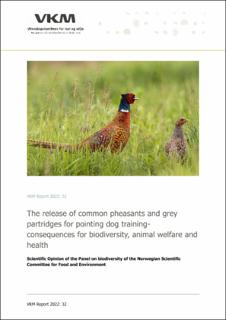| dc.description.abstract | Background Since the late 1800s, an unknown number of common pheasants and grey partridges from captive bred stocks have been released in Norwegian nature. The birds are released to be used for training of pointing dogs. The import, keeping and release of gamebirds, as well as the management of release sites, have been largely unregulated. The consequences to biodiversity, animal health and welfare have not been investigated. The Norwegian Environment Agency (NEA) and the Norwegian Food Safety Authority (NFSA) have jointly requested the Norwegian Scientific Committee for Food and Environment (VKM) for a scientific opinion on the release of common pheasants and grey partridges for pointing dog training regarding consequences for biodiversity, animal welfare of the released birds and health of the released birds as well as wild birds to which pathogens may be transmitted. VKM was further asked to suggest risk reducing measures for biodiversity and animal welfare. Methods VKM established a project group with expertise within avian ecology, landscape ecology, population biology, wildlife veterinary medicine and animal welfare. The group conducted systematic literature searches, scrutinized the resulting literature, and supplemented by other relevant articles and reports. In the absence of Norwegian studies, VKM used literature from other countries where common pheasants and grey partridges (and in some cases other gamebirds), are released, as references. The project group applied observation data of common pheasants and grey partridges in Norway for the period 2000-2022, presented by the Norwegian Biodiversity Information Centre (NBIC). In the assessments, VKM assumed that the release of birds will be in the same order of magnitude as in previous years (a few thousand birds annually on a national level). The number of release sites and the density of released birds per site are unknown. Increasing the number and density of birds would also increase the probability of negative effects and the severity of the consequences. VKM assessed the impacts of released common pheasants and grey partridges on competition, predation, hybridization, transmission of disease, herbivory and indirect impacts through interactions with other species (predator abundance and pathogen-mediated competition). VKM also assessed the impact on biodiversity in a 50-year perspective. Furthermore, VKM discusses how the birds’ welfare might be impacted by rearing, transport, release and exposure to pointing dogs. Finally, VKM provides a list of relevant diseases and assessed their potential impact on animal health during transport, rearing and release. Results and conclusions VKMs assessment show that there are several risks to biodiversity, animal health, and animal welfare from the release of captive bred common pheasants and grey partridges in Norway. The risk of increased competition for food, particularly in winter, with birds with similar niches as common pheasants and grey partridges, is low on a national scale and moderat on a local scale. This is particularly so for yellowhammer, Emberiza citronella, a species categorized as vulnerable on the national red list due to its progressive population decline caused by reduced availability of food during winter. There is a moderate risk for predation on invertebrates and negative impacts on flora. Indirectly, activities connected to the release of birds may lead to moderate risks of altered predator abundance and disease-mediated competition. VKM concludes that the ecological impacts will be more severe for redlisted species present within the release areas for common pheasants and grey partridges. Repeated release of common pheasants and grey partridges can lead to high risk of disease transmission to wild birds. ............. | |
